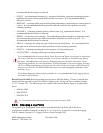9.3.2. Viewing the Central Log (Delogging)
HPSS provides the ability to retrieve and examine HPSS log records as a means of analyzing the activity
and behavior of HPSS. The retrieval and log record conversion process is referred to as “delogging.”
Delogging is the process of retrieving specific records from the HPSS central log files (which is in binary
format), converting the records to a readable text format, and sending the resulting text to a local UNIX
file.
To effectively view log records, the user should know what kinds of activities or behaviors are of
interest. Since it is possible to configure log policies to include almost all activity in HPSS, in most cases
it will be easier to examine and analyze logs by filtering out any records that are not of interest. The
hpss_delog utility allows selective filtering of log records based on start time, end time, server
descriptive name, log record type, user name, principal, authentication mechanism, and authenticator
name.
The central log file names available for delogging are logfile01 and logfile02. These files reside in the
directory name specified in the Log Daemon configuration entry. To determine whether a message of
interest is in a log file, open the associated Log File Information window (Section 9.4: Log Files
Information on page 300) to obtain the start and end times of the log file and compare them with the
message timestamp.
If log files that have been archived to HPSS are to be delogged, they will reside in a date-based directory
structure in HPSS: /log/yyyy/mm/dd. To determine the log times for an archived log file, list the log files.
The timestamp of the time when the file was archived to HPSS is appended to the end of the log file
name. The format of the archive file names is logfile01_yyyymmddhhmm or logfile02_yyyymmddhhmm.
Use the hpss_delog utility to convert the logfile01, logfile02, or archived log file retrieved from HPSS.
Please see the hpss_delog man page for full usage information and examples.
9.4. Log Files Information
HPSS Management Guide November 2009
Release 7.3 (Revision 1.0) 300


















